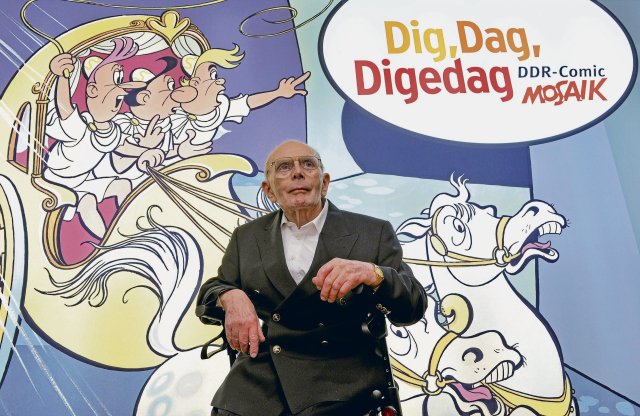A gifted comic artist: Hannes Hegen
Photo: DPA/Hendrik Schmidt
A GDR finding from 1955 is still a cult: Digedags. They were the heroes of a series of image stories in comic-style (a term frowned upon 50 years ago), which can celebrate the 70th anniversary in December. They were conceived by the draftsman Johannes Hegenbarth, who gave himself the short name Hannes Hegen in the youth magazine “Mosaik” founded for the publisher. Hegen had already drawn caricatures for the GDR press for the GDR press. Who was the man around whom many secrets ranked?
On May 16, 100 years ago, he was born in a glassmaker family in Bohemia and got his training in Steinschönau and Vienna before he had to go to war. German -born residents had to leave the Sudetenland after the war, and the Hegenbarths finally went to Ilmenau, Thuringia. Son Johannes was able to study art in Leipzig. Max Schwimmer discovered the special talent of his student for caricatures, and Grand uncle Josef Hegenbarth, a well -known graphic artist and illustrator, mediated orders in Berlin, where he lived from 1951. Among other things, he worked for the “new Berlin illustrated” (“NBI”), designed the lettering of the “Wochenpost”, designed the title for “Das Magazin” and became an indispensable employee in the “fresh wind”, the predecessor of the satire magazine “Eulenspiegel”. But he wanted to develop further.
When he submitted the concept for the magazine “Mosaik” to the publisher in 1955, he met with great interest because the western comic flood was wanted to counter the east-without speech bubbles, as Hegens suggested. Initially, the new magazine appeared quarterly, from summer 1957 monthly at the price of 60 pfennigs. The goblin -like beings Dig, Dag and Digedag quickly became audience favorites with their time travel and adventures among pirates, in the circus, in the old Rome, in space, under invented different eras and soon with Ritter Runkel von Rübenstein in the Middle Ages, before the Orient ended. The imaginative stories that always had a real core, the original figures and, last but not least, the consistent color printing (albeit on bad paper) delighted the readers, whose circle grew constantly.
Hannes Hegen could not do the work alone. He had gathered a “mosaic” collective of artists, and one of them, Lothar Dräger (1927–2016), also proved to be an equally imaginative and historically educated author. He fell a key position when Hannes Hegen overturned with the publisher in the mid -1970s.
When he submitted the concept for the magazine “Mosaic” to the publisher in 1955, he met with great interest because they wanted to counter the western comic flood from the east.
Hegen had had bad experiences in the 1950s when he designed the Rumpelmännchen as a mascot for state old -fashioned retail trade. Because he hadn’t protected the figure, other draftsmen could continue working with it when Hegen had too much work with the “mosaic”. The rights of the digedags were with him. So the publisher, who wanted to continue the “mosaic”, had to find a replacement. Author Lothar Dräger and draftsman Lona Rietschel developed the Abrafaxe: Gnome that were not unlike the Digedags. Hegen complained of plagiarism, but there was a comparison.
Old adventures of the Digedags have now appeared in book form, and Hegen drew additional pictures. Many other drawings were also created, for example when he now accompanied his wife Edith Hegenbarth, who had developed figurines for the “mosaic”, in her work as a costume designer at theater and film.
Adventures of Digedags have been released in well-designed reprint folders at the Tessloff-Verlag since the 1990s. In 1995, director Peter Wohlfeil released a short cartoon with the Digedags and Ritter Runkel, and the so far more of human shy and his wife took part in the premiere in the Potsdam Film Museum in front of her cheering audience. Unfortunately it remained with this one film.
After Edith Hegenbarth died in 2008, Hannes Hegen found enthusiastic employees in the Leipzig Forum in Contemporary History to secure his life’s work. The elderly draftsman was still able to take a look at a first “mosaic” exhibition in 2012. In 2014 he died almost 90 years old.
Nd.Diewoche – Our weekly newsletter

With our weekly newsletter . We’re Doing Look at the most important topics of the week and read them Highlights our Saturday edition on Friday. Get the free subscription here.
His 100th birthday is now celebrated in a variety of ways. The author Harry Rolf Herrling wrote a thick double biography about Josef Hegenbarth and Hannes Hegen, fan magazines, such as “Mosa-Sicke” honor Hannes Hegen with special writings, and as a highlight, a new mosaic with the digedags actually appears on the 100th birthday.
Hannes Hegen’s estate found manuscripts that were supposed to continue the inventor series, which was abruptly broken off in 1964 with issue 89. The series around the submarine inventor Wilhelm Bauer shone the publisher too Klamaukig. The current mosaic publishing house with the nickname “Stone for Stone” has now reactivated the long-time “mosaic” artist Ulf S. Graupner and Steffen Jähde. You have implemented booklet 90 “The duel on the Newa” in the style of the “mosaic” collective, and the printing paper is also reminiscent of old days. The style of Lothar Dräger can be recognized by his verses: “Everyone wants to be the king, only as a water god./ When applause is called, but neither/ whistle or noisy ridicule.” Only the original price from Hegen’s time of 60 pfennigs is clearly exceeded for this collector’s item with 15 euros!
Harry Rolf Herrling: Hannes Hegen and Josef Hegenbarth. Comic legend and master of illustration. Mosamax, 624 pages, born, 59 €.
The duel on the Newa. Mosaic publishing house Stone for Stone, 24 S., Br., 15 €.
